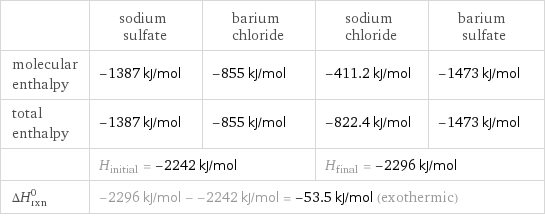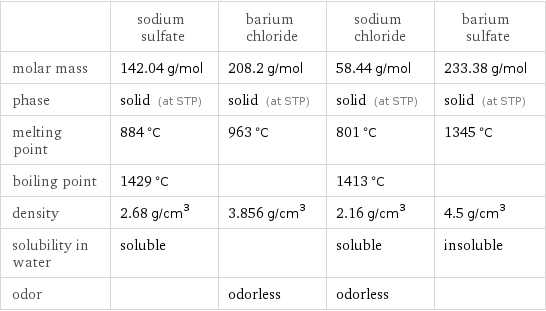Input interpretation

Na_2SO_4 (sodium sulfate) + BaCl_2 (barium chloride) ⟶ NaCl (sodium chloride) + BaSO_4 (barium sulfate)
Balanced equation

Balance the chemical equation algebraically: Na_2SO_4 + BaCl_2 ⟶ NaCl + BaSO_4 Add stoichiometric coefficients, c_i, to the reactants and products: c_1 Na_2SO_4 + c_2 BaCl_2 ⟶ c_3 NaCl + c_4 BaSO_4 Set the number of atoms in the reactants equal to the number of atoms in the products for Na, O, S, Ba and Cl: Na: | 2 c_1 = c_3 O: | 4 c_1 = 4 c_4 S: | c_1 = c_4 Ba: | c_2 = c_4 Cl: | 2 c_2 = c_3 Since the coefficients are relative quantities and underdetermined, choose a coefficient to set arbitrarily. To keep the coefficients small, the arbitrary value is ordinarily one. For instance, set c_1 = 1 and solve the system of equations for the remaining coefficients: c_1 = 1 c_2 = 1 c_3 = 2 c_4 = 1 Substitute the coefficients into the chemical reaction to obtain the balanced equation: Answer: | | Na_2SO_4 + BaCl_2 ⟶ 2 NaCl + BaSO_4
Structures

+ ⟶ +
Names

sodium sulfate + barium chloride ⟶ sodium chloride + barium sulfate
Reaction thermodynamics
Enthalpy

| sodium sulfate | barium chloride | sodium chloride | barium sulfate molecular enthalpy | -1387 kJ/mol | -855 kJ/mol | -411.2 kJ/mol | -1473 kJ/mol total enthalpy | -1387 kJ/mol | -855 kJ/mol | -822.4 kJ/mol | -1473 kJ/mol | H_initial = -2242 kJ/mol | | H_final = -2296 kJ/mol | ΔH_rxn^0 | -2296 kJ/mol - -2242 kJ/mol = -53.5 kJ/mol (exothermic) | | |
Gibbs free energy

| sodium sulfate | barium chloride | sodium chloride | barium sulfate molecular free energy | -1270 kJ/mol | -806.7 kJ/mol | -384.1 kJ/mol | -1362 kJ/mol total free energy | -1270 kJ/mol | -806.7 kJ/mol | -768.2 kJ/mol | -1362 kJ/mol | G_initial = -2077 kJ/mol | | G_final = -2130 kJ/mol | ΔG_rxn^0 | -2130 kJ/mol - -2077 kJ/mol = -53.5 kJ/mol (exergonic) | | |
Equilibrium constant
![Construct the equilibrium constant, K, expression for: Na_2SO_4 + BaCl_2 ⟶ NaCl + BaSO_4 Plan: • Balance the chemical equation. • Determine the stoichiometric numbers. • Assemble the activity expression for each chemical species. • Use the activity expressions to build the equilibrium constant expression. Write the balanced chemical equation: Na_2SO_4 + BaCl_2 ⟶ 2 NaCl + BaSO_4 Assign stoichiometric numbers, ν_i, using the stoichiometric coefficients, c_i, from the balanced chemical equation in the following manner: ν_i = -c_i for reactants and ν_i = c_i for products: chemical species | c_i | ν_i Na_2SO_4 | 1 | -1 BaCl_2 | 1 | -1 NaCl | 2 | 2 BaSO_4 | 1 | 1 Assemble the activity expressions accounting for the state of matter and ν_i: chemical species | c_i | ν_i | activity expression Na_2SO_4 | 1 | -1 | ([Na2SO4])^(-1) BaCl_2 | 1 | -1 | ([BaCl2])^(-1) NaCl | 2 | 2 | ([NaCl])^2 BaSO_4 | 1 | 1 | [BaSO4] The equilibrium constant symbol in the concentration basis is: K_c Mulitply the activity expressions to arrive at the K_c expression: Answer: | | K_c = ([Na2SO4])^(-1) ([BaCl2])^(-1) ([NaCl])^2 [BaSO4] = (([NaCl])^2 [BaSO4])/([Na2SO4] [BaCl2])](../image_source/e23188a03c6cf10b6db68b59b326173e.png)
Construct the equilibrium constant, K, expression for: Na_2SO_4 + BaCl_2 ⟶ NaCl + BaSO_4 Plan: • Balance the chemical equation. • Determine the stoichiometric numbers. • Assemble the activity expression for each chemical species. • Use the activity expressions to build the equilibrium constant expression. Write the balanced chemical equation: Na_2SO_4 + BaCl_2 ⟶ 2 NaCl + BaSO_4 Assign stoichiometric numbers, ν_i, using the stoichiometric coefficients, c_i, from the balanced chemical equation in the following manner: ν_i = -c_i for reactants and ν_i = c_i for products: chemical species | c_i | ν_i Na_2SO_4 | 1 | -1 BaCl_2 | 1 | -1 NaCl | 2 | 2 BaSO_4 | 1 | 1 Assemble the activity expressions accounting for the state of matter and ν_i: chemical species | c_i | ν_i | activity expression Na_2SO_4 | 1 | -1 | ([Na2SO4])^(-1) BaCl_2 | 1 | -1 | ([BaCl2])^(-1) NaCl | 2 | 2 | ([NaCl])^2 BaSO_4 | 1 | 1 | [BaSO4] The equilibrium constant symbol in the concentration basis is: K_c Mulitply the activity expressions to arrive at the K_c expression: Answer: | | K_c = ([Na2SO4])^(-1) ([BaCl2])^(-1) ([NaCl])^2 [BaSO4] = (([NaCl])^2 [BaSO4])/([Na2SO4] [BaCl2])
Rate of reaction
![Construct the rate of reaction expression for: Na_2SO_4 + BaCl_2 ⟶ NaCl + BaSO_4 Plan: • Balance the chemical equation. • Determine the stoichiometric numbers. • Assemble the rate term for each chemical species. • Write the rate of reaction expression. Write the balanced chemical equation: Na_2SO_4 + BaCl_2 ⟶ 2 NaCl + BaSO_4 Assign stoichiometric numbers, ν_i, using the stoichiometric coefficients, c_i, from the balanced chemical equation in the following manner: ν_i = -c_i for reactants and ν_i = c_i for products: chemical species | c_i | ν_i Na_2SO_4 | 1 | -1 BaCl_2 | 1 | -1 NaCl | 2 | 2 BaSO_4 | 1 | 1 The rate term for each chemical species, B_i, is 1/ν_i(Δ[B_i])/(Δt) where [B_i] is the amount concentration and t is time: chemical species | c_i | ν_i | rate term Na_2SO_4 | 1 | -1 | -(Δ[Na2SO4])/(Δt) BaCl_2 | 1 | -1 | -(Δ[BaCl2])/(Δt) NaCl | 2 | 2 | 1/2 (Δ[NaCl])/(Δt) BaSO_4 | 1 | 1 | (Δ[BaSO4])/(Δt) (for infinitesimal rate of change, replace Δ with d) Set the rate terms equal to each other to arrive at the rate expression: Answer: | | rate = -(Δ[Na2SO4])/(Δt) = -(Δ[BaCl2])/(Δt) = 1/2 (Δ[NaCl])/(Δt) = (Δ[BaSO4])/(Δt) (assuming constant volume and no accumulation of intermediates or side products)](../image_source/fde780af92a35535b5abf5b21b8ee090.png)
Construct the rate of reaction expression for: Na_2SO_4 + BaCl_2 ⟶ NaCl + BaSO_4 Plan: • Balance the chemical equation. • Determine the stoichiometric numbers. • Assemble the rate term for each chemical species. • Write the rate of reaction expression. Write the balanced chemical equation: Na_2SO_4 + BaCl_2 ⟶ 2 NaCl + BaSO_4 Assign stoichiometric numbers, ν_i, using the stoichiometric coefficients, c_i, from the balanced chemical equation in the following manner: ν_i = -c_i for reactants and ν_i = c_i for products: chemical species | c_i | ν_i Na_2SO_4 | 1 | -1 BaCl_2 | 1 | -1 NaCl | 2 | 2 BaSO_4 | 1 | 1 The rate term for each chemical species, B_i, is 1/ν_i(Δ[B_i])/(Δt) where [B_i] is the amount concentration and t is time: chemical species | c_i | ν_i | rate term Na_2SO_4 | 1 | -1 | -(Δ[Na2SO4])/(Δt) BaCl_2 | 1 | -1 | -(Δ[BaCl2])/(Δt) NaCl | 2 | 2 | 1/2 (Δ[NaCl])/(Δt) BaSO_4 | 1 | 1 | (Δ[BaSO4])/(Δt) (for infinitesimal rate of change, replace Δ with d) Set the rate terms equal to each other to arrive at the rate expression: Answer: | | rate = -(Δ[Na2SO4])/(Δt) = -(Δ[BaCl2])/(Δt) = 1/2 (Δ[NaCl])/(Δt) = (Δ[BaSO4])/(Δt) (assuming constant volume and no accumulation of intermediates or side products)
Chemical names and formulas

| sodium sulfate | barium chloride | sodium chloride | barium sulfate formula | Na_2SO_4 | BaCl_2 | NaCl | BaSO_4 Hill formula | Na_2O_4S | BaCl_2 | ClNa | BaO_4S name | sodium sulfate | barium chloride | sodium chloride | barium sulfate IUPAC name | disodium sulfate | barium(+2) cation dichloride | sodium chloride | barium(+2) cation sulfate
Substance properties

| sodium sulfate | barium chloride | sodium chloride | barium sulfate molar mass | 142.04 g/mol | 208.2 g/mol | 58.44 g/mol | 233.38 g/mol phase | solid (at STP) | solid (at STP) | solid (at STP) | solid (at STP) melting point | 884 °C | 963 °C | 801 °C | 1345 °C boiling point | 1429 °C | | 1413 °C | density | 2.68 g/cm^3 | 3.856 g/cm^3 | 2.16 g/cm^3 | 4.5 g/cm^3 solubility in water | soluble | | soluble | insoluble odor | | odorless | odorless |
Units
